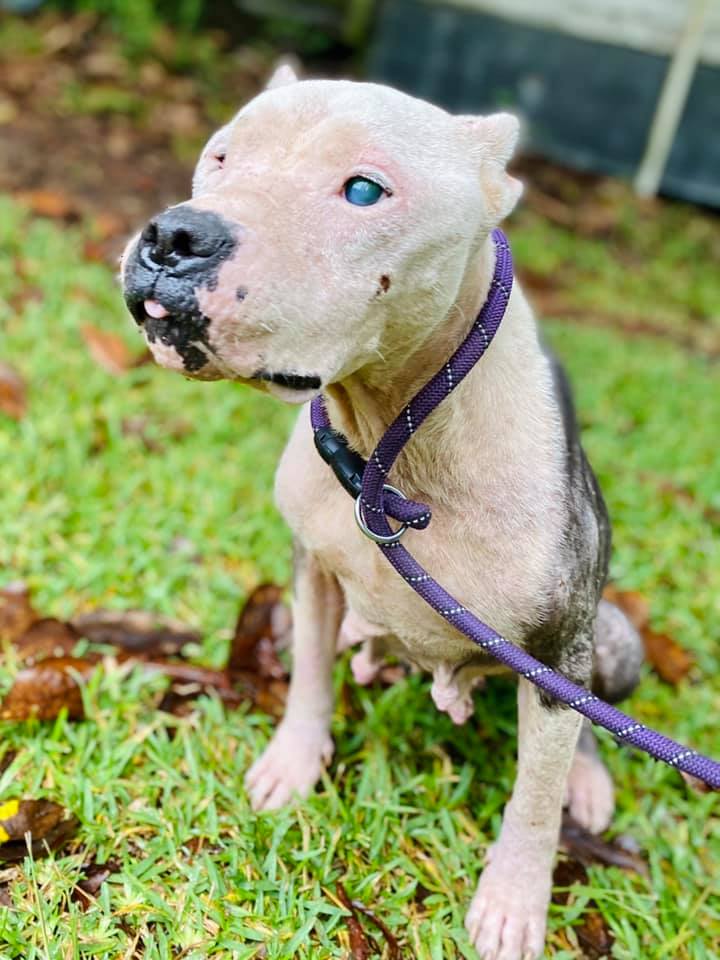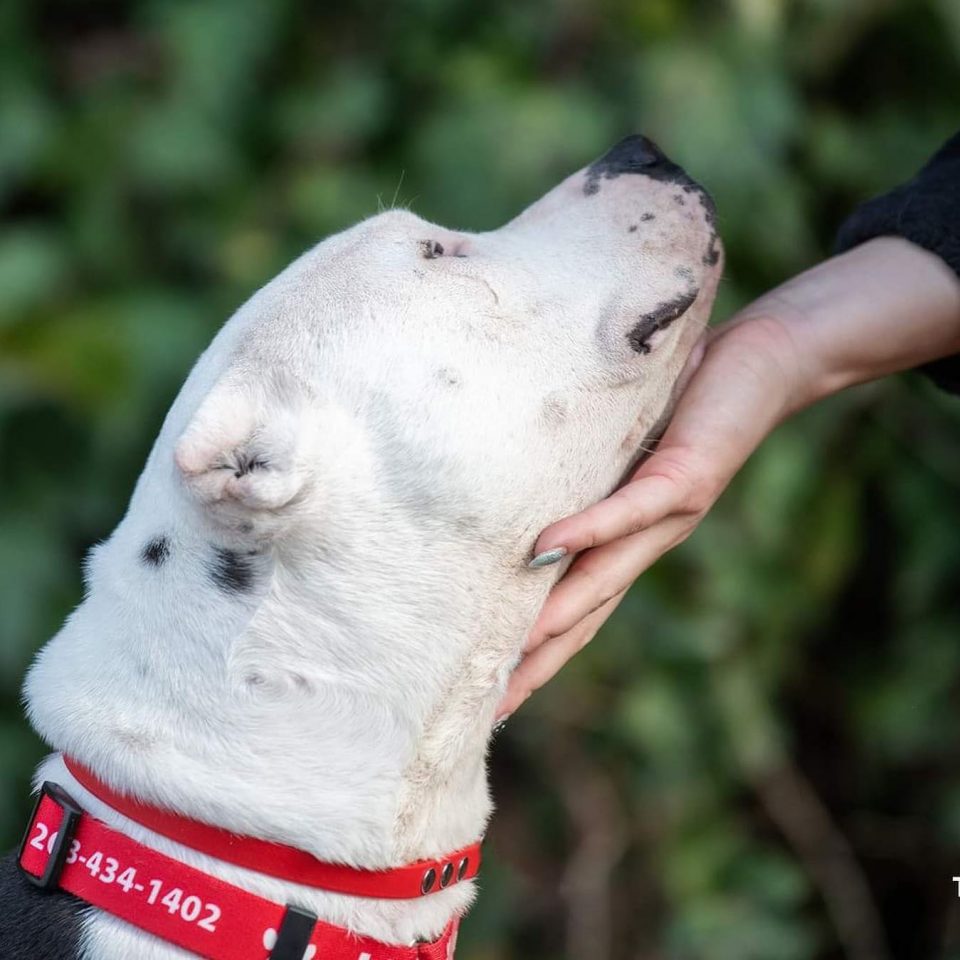Meet Halo – a skinny little girl who was found in the middle of the woods in Mississippi, curled up in the ball and barely alive.
The rescuers received a call about a vicious Pitbull in the woods, but upon arrival, they were shocked by the actual state of the dog.
Just one look at her was enough to completely break their hearts. Halo wasn’t vicious at all.
She was blind, neglected, and emaciated to the point that she was ready to let go if the rescuers didn’t show up.
Curled Up In The Forest

Stacey and her husband, Mike, play a huge role in the rescue community in Mississippi.
If you have adopted a Mississippi rescue dog from the Lucky Dog Refuge shelter in Stamford, Connecticut, chances are that Stacey was the one who gave them a second chance.
Halo was one of those many dogs.
When Halo was found in the middle of the woods, she was literally a skeleton – just skin and bones.
Stacey and her husband somehow managed to draw her out of the woods with the help of some delicious food, but her condition was terrifying.
Because of her condition, it was clear that poor Halo had been denied basic necessities, such as food and shelter for weeks, months, if not years.
She was most likely used for breeding until the moment she wasn’t ‘useful’ anymore to her owner, so they decided to dump her in the woods.

“Her ears were cut with a pair of scissors, and she was most likely used for breeding. One eye is injured and damaged, the other is blind probably from an eye disease that should have been treated,” Stacey Frazier wrote in her Facebook post.
It is simply terrifying to think what this poor dog had endured, but thankfully, she has finally found herself in the right hands.
The Road To Recovery

They decided to name her Halo because they weren’t even sure if she was going to make it, but luckily, she did.
Stacey brought her home, and they immediately started her treatment with some antibiotics and good nutrition.
There were a couple of moments when they really weren’t sure if she was going to make it, but she was a true fighter.
“We knew that her sight was definitely impaired, but we didn’t know if she was fully blind until the doctor confirmed it. We do think that she can see shadows, but she’ll just walk right into a telephone pole,” Jessica from Lucky Dog Refuge told The Dodo.

With Stacey, Halo finally understood what love truly feels like. For the first time ever in her life, she was treated nicely by one human being, so she was very happy.
It took months for her to finally recover, and when she finally did, it was time for her transfer to the rescue in Connecticut.
Halo Found A Forever Home

Once Halo arrived at the rescue, she was so happy – a completely different dog from when she was found in the woods.
The shelter quickly found out that Halo loved ice cream and would always get so excited to get one.
“She lets us know every day that she’s grateful for everything that she has now. She’s just an angel,” Jessica said.
However, one thing was still missing – a loving forever home.
Then, the most amazing thing happened – beautiful little Halo found the perfect forever home where she’s simply thriving.
But, that’s not all – her pawrents also decided to adopt Halo’s best friend from the shelter – Layne – so the two are now living their best lives together.

Enjoy your new life, Halo, you deserve it!
Check out Halo’s story here:
If you’ve ever wondered about those pesky tapeworms and how they end up in your furry friend, understanding the ins and outs can be quite enlightening. Picture this: your dog, with their curious nature, exploring the world around them, sniffing here and there, possibly ingesting something they shouldn’t. That’s where the trouble begins.
Imagine a scenario where your pup encounters a flea during their outdoor adventures. These tiny parasites can carry tapeworm larvae, and if your dog swallows an infected flea while grooming, that’s the gateway for tapeworms to enter their system. It’s a common occurrence, but fret not, there are ways to prevent and treat these unwelcome guests in your canine companion.
Understanding Tapeworms in Dogs
Tapeworms in dogs are commonly caused by the ingestion of infected fleas. These pesky parasites can also be transmitted by ingesting infected rodents or raw meat containing tapeworm larvae.
The most common type of tapeworm affecting dogs is Dipylidium caninum. These tapeworms consist of small segments that can be seen in your dog’s feces or around their bottom, resembling grains of rice.
When a dog ingests an infected flea during grooming or scavenging, the tapeworm larvae develop in the dog’s intestines, growing into adult tapeworms. These parasites then attach themselves to the intestinal wall, feeding off the nutrients consumed by your furry friend.
Symptoms of tapeworm infestation in dogs may include scooting (dragging their bottom along the ground), visible tapeworm segments in the feces or around the anus, weight loss, and occasional irritation around the dog’s rear end.
To diagnose tapeworms in dogs, veterinarians may conduct a fecal examination to identify tapeworm eggs or segments. Treatment usually involves deworming medications prescribed by your vet, which effectively eliminate tapeworms from your dog’s system.
Preventing tapeworm infestations in dogs involves regular flea control to prevent your dog from ingesting infected fleas. Additionally, practicing good hygiene, such as cleaning up after your dog and avoiding raw meat, can help reduce the risk of tapeworm infections.
Common Ways Dogs Get Tapeworms
Tapeworms are pesky parasites that can easily find their way into your dog’s system. Here are the common ways your furry friend can get tapeworms:
1. Ingesting Infected Fleas
Tapeworm eggs are commonly found in fleas. When your dog ingests an infected flea while grooming, playing, or even just exploring outside, they can become host to tapeworms.
2. Consuming Infected Prey
Dogs with a natural hunting instinct may catch and consume rodents or other small animals. If these prey are carrying tapeworm larvae, your dog can get infected by eating them.
3. Eating Raw Meat
Feeding your dog raw meat, whether intentionally or accidentally, can pose a tapeworm risk. Raw meat may contain tapeworm cysts, which, if ingested by your dog, can develop into adult tapeworms in their intestines.
4. Direct Contact with Infected Feces
Dogs can pick up tapeworm eggs by coming into contact with infected feces, either from other animals or contaminated environments. Ingestion of these eggs can lead to tapeworm infestation.
5. Close Contact with Infected Dogs
If your dog interacts closely with other infected dogs, either through shared spaces, socializing, or grooming each other, there’s a risk of transmitting tapeworms between them.
Knowing how these sneaky parasites can find their way into your dog’s system can help you take preventive measures to keep your canine companion healthy and happy.
Signs and Symptoms of Tapeworm Infection in Dogs
When it comes to tapeworm infections in dogs, there are some key signs and symptoms to watch out for. Here’s what you should look for:
- Visible Tapeworm Segments: One of the most obvious signs of tapeworm infection in dogs is the presence of small, white, flat segments resembling grains of rice around the dog’s rear end or in their feces.
- Itchy Rear End: Dogs infected with tapeworms may frequently drag their hind end on the ground or lick their anal area due to the irritation caused by the worms.
- Weight Loss: Sudden weight loss in your dog, despite a normal appetite, could be a sign of a tapeworm infestation stealing vital nutrients from your pet.
- Potbellied Appearance: An extended or swollen abdomen that gives your dog a potbellied appearance may indicate a severe tapeworm infection.
- General Signs of Illness: Dogs with tapeworms might exhibit general signs of illness, such as lethargy, diarrhea, vomiting, or a dull coat.
- Increased Appetite: Some dogs infected with tapeworms may paradoxically show an increase in appetite as the worms steal nutrients from the dog’s stomach.
If you notice any of these signs or symptoms in your furry friend, it’s crucial to consult your veterinarian for a proper diagnosis and treatment. Regular check-ups and prompt action can help keep your dog healthy and happy.
Diagnosing and Treating Tapeworms in Dogs
When it comes to your furry companion’s health, diagnosing and treating tapeworms promptly is crucial. Here’s how you can take action:
1. Veterinary Examination:
If you suspect your dog has tapeworms due to symptoms like visible worm segments or unexplained weight loss, it’s time to visit your vet. They’ll conduct a thorough examination, including a fecal test to confirm the presence of tapeworms.
2. Deworming Medication:
Once the diagnosis is confirmed, your vet will prescribe appropriate deworming medication tailored to treat tapeworm infections. It’s essential to follow your vet’s instructions carefully regarding dosage and administration to ensure effective treatment.
3. Preventive Measures:
Prevention is key in keeping tapeworms at bay. Your vet may recommend proactive measures like regular flea control treatment to prevent re-infestation. Additionally, maintaining good hygiene practices and avoiding your dog’s contact with potentially infected substances can help reduce the risk of tapeworms.
4. Regular Check-ups:
After treatment, it’s important to schedule follow-up appointments with your vet to monitor your dog’s recovery and ensure the tapeworms have been successfully eradicated. Your vet may recommend periodic fecal tests to confirm that your dog is free from tapeworms.
By staying vigilant, seeking prompt veterinary care, and following preventive measures, you can effectively diagnose, treat, and protect your beloved pet from the discomfort and health risks associated with tapeworm infections.
Conclusion
That’s the scoop on how dogs can pick up those pesky tapeworms. Remember, keeping an eye out for symptoms like itching, weight loss, or visible segments is key. If you suspect your furry friend might have tapeworms, don’t hesitate to reach out to your vet for a check-up. Treatment typically involves deworming meds and preventive measures like flea control. Stay on top of your pup’s health with regular vet visits to ensure they stay tapeworm-free and happy.
Frequently Asked Questions
How do dogs get tapeworms like Dipylidium caninum?
Dogs can get tapeworms like Dipylidium caninum by ingesting infected fleas or consuming raw meat. It is essential to prevent these modes of transmission to protect your pet’s health.
How are tapeworm infections in dogs diagnosed?
Tapeworm infections in dogs are diagnosed through fecal examinations. Consulting a veterinarian for proper diagnosis is crucial for effective treatment.
What are the signs of tapeworm infection in dogs?
Signs of tapeworm infection in dogs include visible tapeworm segments in feces or around the anus, itching, weight loss, a potbellied appearance, general signs of illness, and increased appetite.
How are tapeworms treated in dogs?
Tapeworms in dogs are treated with deworming medications prescribed by a veterinarian. It is important to follow the treatment regimen to ensure complete eradication of the parasite.
How can tapeworm infections be prevented in dogs?
Preventing tapeworm infections in dogs involves measures such as flea control to eliminate potential sources of infection. Regular veterinary check-ups can also help monitor your pet’s health and prevent re-infection.
[no_toc]

Hey there, I’m Janet Brooks, a dog-loving student from California. I’m all about helping pups in need, especially those without homes. Me and my awesome friends work together to give shelter and love to stray dogs. Oh, and I also write blogs about dogs to share helpful info.